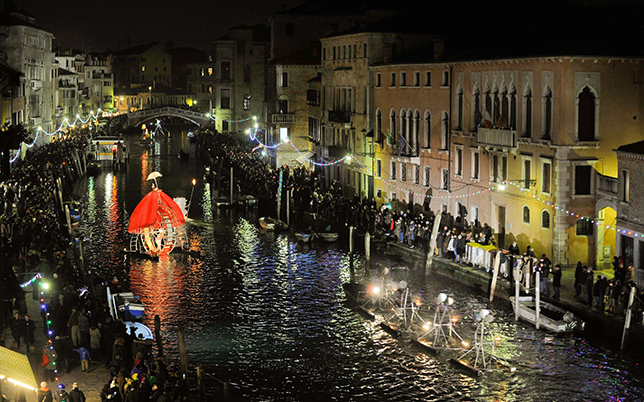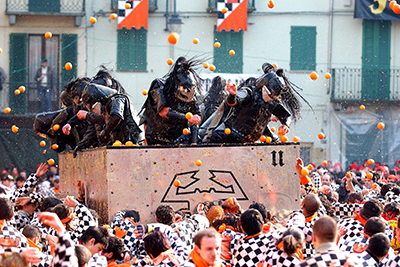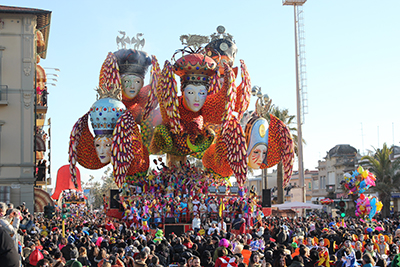Evocative of unbridled fun and colorful costumes, carnival (or carnevale in Italian) originates from ancestral rituals performed in the occasion of the arrival of the warm season to bode well for the imminent harvest. Today, all over Italy, carnival season means wild parties, allegoric carriages and funny masks, and every region proudly preserves their own traditions.
Be it a spectacular parade, an ancient ceremony or a thrilling horse tournament, here are some of the main carnivals in Italy, and depending on your passions, you can pick the type of amusement you prefer and join the fun.
Venice
Probably Italy’s most famous carnival, the origins of Venice’s celebrations date back to the 11th century, when the city’s rulers decided to grant the population with a short period every year to have fun with parties and festivals. Those were the only days when they could feel, even though for a fleeting moment, part of the wealthy community and even mock the rich, thanks to the masks worn to hide their face.
Celebrations last for about three weeks (February 15 to March 4), and some of the most traditional events are La Festa delle Marie, where 12 local girls are selected to reproduce the Middle Ages tradition of the parade of newlywed brides belonging to the noble class, and the spectacular Volo dell’Angelo (Angel’s Flight), during which an artist descends from the bell tower of San Marco Basilica. The core of the celebrations occurs on March 2 and March 4 (Mardi Gras), just before Lent begins, starting in Piazza San Marco at 10:30 a.m. with the parades of beautiful masks, and ending at the Arsenal in the evening with fireworks, dancing fountains and live music.
To fully enjoy the festival, your best bet is to book your accommodations in the surroundings of Piazza San Marco. Luna Hotel Baglioni, just around the corner from the famous Harry’s Bar, is finely decorated with vintage furniture and Murano glass chandeliers, and boasts a private dock for the guests to arrive by boat; while Bauer Il Palazzo, a three-minute walk from Piazza San Marco, offers a stunning view of the Grand Canal and a gourmet restaurant, De Pisis, which serves a gourmet menu for dinner (think squid ink risotto and Venetian-style prawns) and a buffet breakfast every morning.
Ivrea
The very origins of Ivrea’s carnival can be traced back to mysterious Roman Bacchanals and the parties in honor of Dionysus in ancient Greece. In the 19th century, inspired by the spirit of the Risorgimento, a series of uprisings that resulted in the Italian unification, the festival sought to symbolize a popular revolt that happened in the 12th century against tyrant Ranieri di Biandrate and led by the Mugnaia, a miller’s daughter who, according to tradition, killed the dictator and showed his head to the citizens announcing the city’s freedom.
The main event of Ivrea’s carnival is the wild Battle of the Oranges, where thousands of people, some on carriages and some on the streets, throw oranges at each other, in an attempt to reproduce the old customs of noble girls throwing flowers, confetti and oranges from their balconies. The Battle of the Oranges takes place on March 2 and March 4 around 2 p.m., after Mugnaia parades through the streets on her carriage.
Some of the best hotels in Ivrea are Spazio [Bianco], offering exquisitely decorated rooms, each one inspired by a specific aspect of the culture, be it the nearby castles or the local vineyards; and cozy La Villa Hotel, with rooms equipped with satellite TV and Wi-Fi connection, and flaunting beautiful views of the Alps.
Sardinia
On the island of Sardinia, carnival is strongly linked with millennia-old traditions. Among the can’t-miss celebrations is Oristano’s Sartiglia, a thrilling horse race where riders perform acrobatic stunts from the saddle. Medieval Europe was the realm of equestrian tournaments, and in Oristano’s Sartiglia, the riders, dressed in rich costumes belonging to both Sardinian and Spanish legacies, are the main feature. The event takes place on March 2 and March 4, starting around noon with the solemn dressing of the horsemen, and carrying on at 1:30 p.m. with the first race, Corsa della Stella, and the acrobatic tournament around 4:30 p.m.
If you think a carnival dating back to Middle Ages isn’t old enough, head east toward Mamoiada, a scenic hamlet in Sardinia’s obstreperous Barbagia region, and enjoy a 2,000-year-old ritual. As history goes, this festival wasn’t born for carnival purposes, but instead as a propitiatory ceremony to appease the gods and bring about a good harvest. When Christianity took over, newly appointed clerics didn’t manage to erase existing myths, so they allowed the faithful to perform them right before Lent, when they will have plenty of time to repent. The ritual will take place on March 2 and Shrove Tuesday, March 4, when the undisputed stars of the festival, the Mamuthones, men clad in black sheepskin, carrying nearly 70 pounds of cowbells on their backs and wearing wooden handmade masks (the uglier, the better), parade along the main streets dancing rhythmically in two parallel lines.
If you feel like experiencing a thrilling carnival in Oristano, you can book Mistral Hotel in the historic city center, offering all comforts and a restaurant serving regional cuisine; or Il Duomo Hotel, boasting a fine eatery with regional dishes such as spaghetti with mint, zucchini and bottarga (fish eggs); raw shellfish; and local beef rib steak.
On the other hand, to fully immerse yourself in the island’s primordial spirit with Mamoiada’s carnival, you can book a room at the charming bed-and-breakfast, Perda Pintà, to enjoy a cozy environment and a homemade breakfast with the view of the prehistoric menhir (sacred stone) discovered on the property in 1997, or at the finely decorated bed-and-breakfast, S’Ortensia, which provides private parking and homemade breakfast.
Viareggio
Founded in 1873, Viareggio’s carnival has different themes every year. For this 2014 edition, the 141st, some of the topics for the floats and masks chosen by the festival’s masters are the economic crisis and people’s dreams and fears; the Internet and the dangers behind it; the lost city of Atlantis; a tribute to two stars of international music, John Lennon and Freddie Mercury; as well as the always present mockery of Italy’s political establishment.
The parades of huge allegoric floats take place on March 2, March 4 and March 9, when there is the nomination for the best float. The carnival concludes on March 9 with the announcement of the winners and fireworks.
To be close to the celebrations, one of the best spots to stay in Viareggio is Hotel Residence Esplanade, a Liberty-style building located near the Tyrrhenian Sea where beautifully refurbished rooms come with satellite TV and the restaurant serves seasonal Tuscan specialties (think lobster ravioli).
Putignano
One of Italy’s (and Europe’s) oldest carnivals, Putignano’s festivities, in the southern Puglia region, have been taking place for more than 600 years. Of uncertain origins, its inception is said to reach back to 1394, the year when the Knights of Malta decided to transfer the relics of martyr St. Stephen here. The news was welcomed with joy by the townspeople, who followed the saint in an impromptu procession that, after the religious ceremony was over, became a wild party involving dancing, music, jokes and parody acts.
Apart from contests, exhibitions, theater plays and music shows, the main events of the festivals are the masquerade parades. This year, they’re a tribute to Italian composer Giuseppe Verdi, taking place along the city’s main streets on March 2 at 11 a.m., March 4 at 7 p.m. and March 9 at 11 a.m.
If you wish to stay in Putignano, we suggest Arco Michele, a bed-and-breakfast housed in a traditional stone building located in the city center. However, if you prefer the comforts of a luxury resort, Park Hotel La Grave, in nearby town Castellana Grotte, is elegantly decorated in typical Mediterranean style and features a restaurant serving authentic traditional cuisine and an international breakfast with freshly prepared cakes, pastries, cereals, fruit juice and coffee.
Photos Courtesy of Carnevale di Venezia, Fondaz Storico-Carnevale di Ivrea and Fondazione Carnevale di Viareggio



